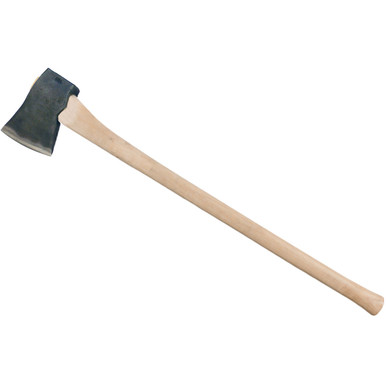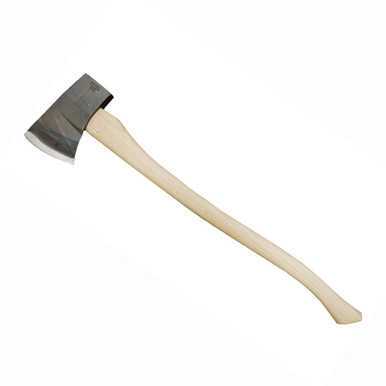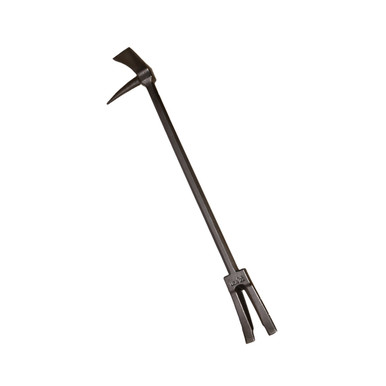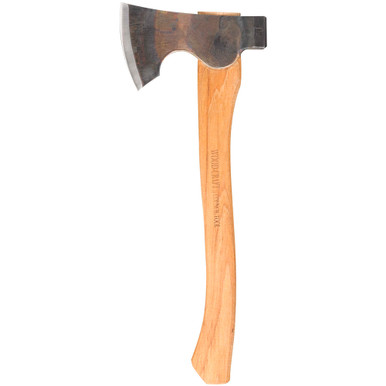Council Tool
- In StockCOUNCIL TOOL 3.5 lbs. Jersey Classic Axe w/ 32in Curved Handle (SU35JC32C)Forged tool steel head. Made in USAHand sharpened, tapered bit for cutting and splittingANSI Standards call for bit hardness of Rc 45-60, at least 1/2 inch back from the cutting edge. Council Tool ...
 $71.99
$71.99 - In StockCOUNCIL TOOL 1.5 lbs Pickaroon w/ 28in Straight Hickory Handle (SU150PKR28S)1.5 lbs. head with good balance3-sided pick, sharpened to a point out of the boxUnder-cutter on the bottom side of the pick that can be used to cleave off small limbs, and brushLarge poll face to ...
 $50.99
$50.99 - In StockCOUNCIL TOOL Sport Utility 3.5lb Jersey Pattern Axe with 36in Straight Hickory Handle (SU35J36S)Forged tool steel head made in the USAHand-sharpened, tapered bit for cutting and splittingBit hardness Rc 48-55, targeting 1-1/4" from the cutting edgePoll and eye walls remain as-forged for ...
 $64.99
$64.99 - In StockCOUNCIL TOOL FE6 Forcible Entry 6lb Flathead Fire Axe with 32in Hickory Handle (60FMS32C)Forged 4140 steel head to match Council Halligan. Made in USAForged in slot to marry most popular Halligan tools to create "The Irons"Tapered wedge shaped blade allows it to be used a ...
 $74.99
$74.99 - In StockCOUNCIL TOOL Double Bit 3.5lbs Classic Michigan Axe (SU35-2MC)Forged tool steel headHand sharpened double bits for cutting and splitting, sharpened in the same mannerANSI Standards call for bit hardness of Rc 45-60, at least 1/2 inch back from the cutting ...
 $68.99
$68.99 - In StockCOUNCIL TOOL Hudson Bay 2lbs 24in Camp Axe (SU20HB24C)Hand sharpened, tapered bit for cutting and light splittingANSI Standards call for bit hardness of Rc 45-60, at least 1/2 inch back from the cutting edge. Council Tool internal standards call for ...
 $57.99
$57.99 - In StockCOUNCIL Halligan Style 24in Forcible Entry (HAL1P24)Overall length is 24 inMade of .987" Octagon 4140 steelMatte Black finish to to deter rust and stealth ops2" Wide offset Adze w/ 30" radial arc and reference lineSquared off ...
 $194.99
$194.99 - In StockCOUNCIL TOOL 5 lbs Single Bit Dayton 28in Axe (50DR28S)Forged tool steel head, Made in USA5 lbs. head weight4-3/4" Bit length from toe-to-heel7-3/8" Overall head length from bit-to-pollLonger poll for balance, and a larger surface area, ...
 $57.99
$57.99 - In StockCOUNCIL TOOL Forcible Entry 6lb Flathead Fire with 36in Hickory Handle Axe (60FMS36C)Forged 4140 steel headTop of head is flat to stand on its ownHand sharpened, tapered bit for cutting36" curved hickory handleAxe head is hydraulically seated onto handle and secured with a ...
 $77.99
$77.99 - In StockCOUNCIL TOOL 1.5 lbs Pickaroon with 36in Curved Hickory Handle (SU150PKR36C)Body coated with red enamel36 in American hickory handleHeat treated working end This Council Tool 1.5lb Sport Utility Pickaroon features forged tool steel head. Heat treated working end ...
 $50.99
$50.99 - In StockCOUNCIL TOOL Dayton Miners 20in Straight Handle 3.5lb Axe (35MD20)3.5# Dayton pattern single bit axe with 20" straight handleHand sharpened, tapered bit for cutting and splittingBody coated with red enamel and the cutting edges in clear lacquer to deter ...
 $48.99
$48.99 - In StockCOUNCIL TOOL 1.75lbs Camp Hatchet with 14in Curved Hickory Handle (SU20HCT14C)Forged tool steel head. Made in USAHand sharpened, tapered bit for cutting and light splittingHead coated with boiled Linseed Oil over the as forged finish14" curved American hickory handle. ...
 $40.99
$40.99 - In StockCOUNCIL TOOL Halligan Style Forcible Entry Tool (HAL1P30)Perfect for fire fighters and personal useMade of .987" Octagon 4140 steelHeat treated for superior strengthWith forged-in holes for strappingOverall length: 30"Made in the USA The ...
 $191.99
$191.99 - In StockCOUNCIL TOOL 28in Curved Single Bit Replacement Axe Handle (70-005)28" curved wooden single-bit axe handle (boy's axe)Eye section is dried to below 10% moisture content to minimize shrinkage and help prevent looseningMade in the USA COUNCIL TOOL 28" ...
 $23.99
$23.99 - In StockCOUNCIL TOOL 5lbs Dayton Pattern SB Axe (SU50D36S)Forged tool steel headLarger poll, balanced head, and wedge shaped bladeWedge-shaped blade, with a high centerline, to help keep it from sticking while splittingCouncil Tool internal standards ...
 $67.99
$67.99 - In StockCOUNCIL TOOL 1.625# Flying Fox Camping/Throwing Hatchet (SU162FF22S)Hardened bit and pollHandle has a large hatchet eye, trimmed to be under 22" (Hickory)Head weight: 1 lbs. 11 ozBit length: 3 7/8" The Flying Fox Woodsman Hatchet is a multi-use camp ...
 $45.99
$45.99 - In StockCOUNCIL TOOL 1.25# Hudson Bay Camp Axe With 14in Curved Hickory Handle (SU125HB14C)Hand sharpened, tapered bit for cutting and light splittingCouncil Tool internal standards call for tempered bit hardness of Rc 48-55Head coated with boiled Linseed Oil over the as forged finish14 ...
 $44.99
$44.99 - In StockCOUNCIL TOOL Michigan Double 36in Straight Handle 3.5lb Bit Axe (35-2MR)3.5 lb. Michigan pattern double bit axe with a 36" straight handleHand sharpened double bits for cutting and splitting, sharpened in the same mannerHead coated with red enamel and cutting ...
 $53.99
$53.99 - In StockCOUNCIL TOOL 1.7# Wood-Craft Camp Carver 16in Handle Axe With Leather Mask (WC17CCA16C)Hardened poll90 deg. SpineLarge hatchet eyeBearded bladeWelted Leather mask5160 Steel 1.7# Wood-Craft Camp Carver, 16" Curved Handle, with a high quality Leather Mask: The Council Tool Co.'s ...18% off
 $113.99$139.23
$113.99$139.23 - In StockCOUNCIL TOOL Velvicut Hudson Bay 19in Handle 2lb Axe (JP20HB19C)2# Hudson Bay Premium Velvicut axe is a shape and size ideal for camping, hunting or hiking expeditionsForged from 5160 grade alloy steelBit is heat treated and quenched approximately 1" inch ...23% off
 $110.99$144.81
$110.99$144.81
